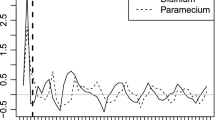Abstract
In this paper we present a hierarchical Bayesian analysis for a predator–prey model applied to ecology considering the use of Markov Chain Monte Carlo methods. We consider the introduction of a random effect in the model and the presence of a covariate vector. An application to ecology is considered using a data set related to the plankton dynamics of lake Geneva for the year 1990. We also discuss some aspects of discrimination of the proposed models.
Similar content being viewed by others
References
Arditi R, Abillon J, Vieirada Silva J (1978) A predator–prey model with satiation and intraspecific competition. Ecol Modell 5: 173–191
Bazykin AD (1985) Mathematical models in Biophysics. Nauka, Moscow
Boyce WE, DiPrima RC (1977) Elementtary differential equations and boundary value problems. Wiley, New York
Cangelosi AR, Hooten MB (2008) Models for bounded systems with continuous dynamics. Biometrics In Press
Gelfand AE, Smith AFM (1990) Sampling-based approaches to calculating marginal densities. J Am Stat Assoc 85(410): 398–409
Gelman A (2006) Prior distribution for variance parameters in hierarquical models (comment on article by browne and draper). Bayesian Anal 1: 515–534
Gelman A, Rubin BD (1992) Inference from iterative simulation using multiple sequences. Stat Sci 4: 457–511
Gianni G, Pasquali S, Ruggeri F (2008) Bayesian inference for functional response in a stochastic predator–prey system. Bull Math Biol 70: 358–381
Goel NS, Maitra SC, Montroll EW (1971) On the volterra and other nonlinear models of interacting populations. Rev Modern Phy 43: 231–276
Gompertz B (1825) On the nature of the function expressive of the law of human mortality. Philos Trans 115: 513–583
Gutierrez A (1992) The physiological basis of ratio-dependent predator–prey theory: a metabolic pool model of nicholson’s blowflies as an example. Ecology 73: 1552–1563
Harrison GW (1995) Comparing predator–prey models to luckinbilláas experiment with didinium and paramecium. Ecology 76: 157–174
Hassel MP, Varley GC (1969) New inductive population model for insect parasites and its bearing on biological control. Nature 223: 1133–1137
Jost C (1998) Comparing predator–prey models qualitatively and quantitatively with ecological time-series data. Ph.D. Thesis, Institut national agronomique Paris-Grignon
Lotka AJ (1924) Elements of physical biology. Willians and Wilkins, Baltimore, MD
Malthus TR (1798) An essay on the principle of population and a summary view of the principle of population. England, Harmondsworth
Philip JR (1957) Sociality and sparce populations. Ecology 38: 107–111
Smith AFM, Roberts GO (1993) Bayesian computation via the Gibbs sampler and related Markov chain Monte Carlo methods. J R Stat Soc Ser B 55(1): 3–23
Smith FE (1963) Population dynamics in daphnia magna and a new model for population growth. Ecology 44: 651–663
Spiegelhalter DJ, Thomas A, Best NG, R GW (1995) BUGS: Bayesian inference using Gibbs sampling, Version 0.50. Cambridge: MRC Biostatistics Unit
Spiegelhalter DJ, Best NG, Vander Linde A (2000) A bayesian measure of model complexity and fit (with discussion). J R Stat Soc Ser B 64: 583–639
Strebel DE, Goel NS (1973) On the isocline methods for analysing prey–predator interactions. J Theor Biol 39: 211–234
Sutherland WJ (1983) Aggregation and the “ideal free” distribution. J Anim Ecol 52: 821–828
Szathmary E (1991) Simple growth laws and selection consequences. Trends Ecol Evol 6: 366–370
Verhulst PFE (1838) Notice sur la loi que la population suit dans son accroissement. Correspondances Mathematiques et physiques 10: 113–121
Volterra V (1926) Fluctuations in the abundance of a species considered mathematically. Nature 118: 558–560
Volterra V (1938) Population growth, equilibria, and extinction under specified breeding conditions: a development and extension of the theory of the logistic curve. Hum Biol 10: 1–11
Von Bertalanffy L (1951) Theoretische Biologie. 2. A. Frank, Bern
Yeargers EK, Showkwiller RW, Herod JU (1996) An Introduction to mathematics of biology: with computer algebra models. Birkhauser, Boston
Author information
Authors and Affiliations
Corresponding author
Rights and permissions
About this article
Cite this article
Achcar, J.A., Mazucheli, J. & Coelho-Barros, E.A. Predator–prey models: an application for the plankton dynamics of lake Geneva. Environ Ecol Stat 18, 315–329 (2011). https://doi.org/10.1007/s10651-010-0134-z
Received:
Revised:
Published:
Issue Date:
DOI: https://doi.org/10.1007/s10651-010-0134-z




